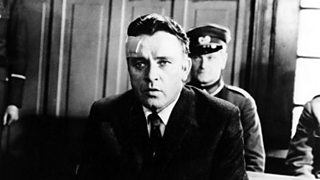Forty five years ago the Cold War classic The Spy Who Came In From The Cold, starring Richard Burton, was released. Alongside Claire Bloom and Oskar Werner, Burton played the flawed and manipulated spy Alec Leamas, the "lowest currency of the Cold War" who, in a world of courtrooms and Kalashnikovs, ends up betrayed, heartbroken and riddled with bullets.

Richard Burton
Adapted from the John le Carré novel, and directed by Martin Ritt, the film went on to receive four BAFTAs, with Burton getting one of his seven Oscar nominations in the process. The film served as a shining example of of the period's paranoia by framing the monochrome reality of spy games, hinting at a terrifying future in the process.
Between 1945 and 1991 the Soviet Union and the USA faced off in an atmosphere of potentially catastrophic brinkmanship. With nuclear warheads trained on each other's cities no nation would be safe from any exchange. The Cuban Missile Crisis, Korean War, and the were just a few near misses that held the world on the brink of nuclear catastrophe. Most nations planned for the worst, and Wales was no exception.
Similar bunkers were built from the 1950s onwards to house regional government in the event of all-out war. Coryton held this infamous role until the late 50s, eventually replaced by RSG 8 at Brecon.
"By the late 1960s RAF Valley, RAF Brawdy, Cardiff and Swansea were thought to be the likely Welsh targets in a nuclear attack on Britain," says , senior lecturer in History at Swansea University. "Brecon was also considered a possibility since it had been mooted as a centre for a regional government in any future war.
"People in Cold War Wales were all too aware that Wales was also part of the bigger world, a world that was dangerous and insecure. Taking note of this sense of unease is all the more important because it offers a different picture to the idea of post-war affluence.
The remains of civil defence are scattered throughout Wales. They range from non-descript overgrown concrete blocks to a . During the Cold War such installations existed at Swansea, Prestatyn, , Brackla and Caerwent - home of the United States Air Force's main non-nuclear bomb store in Britain.
The fear of a Soviet attack containing hundreds of nuclear warheads touched young and old throughout Wales for decades. The intrigues and fear manifested itself in fiction and popular culture. From Leamas' weary and tragic figure to Michael Caine's role as Harry Palmer in and . Add to that the 成人论坛's glorious, terrifying part-drama, part-documentary , where the city of Sheffield is subject to the horror of nuclear war and a whole range of anxiety and horror is revealed.
Jeremy Paxman described how it could have really been in this clip from a 1980 episode of Panorama, titled ...If The Bomb Drops.
"In 1953 civil servants estimated that three 'Nagasaki type' bombs might be dropped on Wales in the event of a war with the USSR," adds Johnes. "Assuming evacuation plans worked, they calculated - or guessed, given the lack of actual evidence - that 6,000 people would be killed in Cardiff, 4,000 in Swansea and 16,000 in Newport.
"Added to this, another 8,000 people would be seriously injured in the three places and 39,000 houses destroyed or irreparably damaged. The total death toll in Britain would be over 1.3 million."
